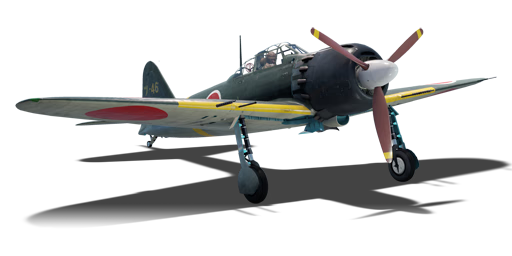



The A6M5 mod. 52 Hei, designated as the Type 0 Carrier-based Fighter Model 52C (零式艦上戦闘機五二型丙), was the third and last minor modification of the A6M5. It offers the most firepower of the A6M series, with the inclusion of a Type 3 (13.2 mm) HMG in each wing and 4 rocket racks underneath, and on top of that, the last Type 97 (7.7 mm) was removed. Next to armament changes, it also increases the survivability of the plane with thicker wing armour, and armour was installed behind the pilot seat. Because of the gain in weight, this variant was used mainly for intercepting B-29s and special attacks.
It was introduced in Update "Ixwa Strike". Together with the A6M6 mod.53, the A6M5 mod. 52C is a heavy interceptor attacker variant of the A6M which deplete their manoeuvrability for more armament, ordnance and survivability. This A6M shouldn't be conventionally used like its previous models, being far heavier and less manoeuvrable leaves it to be forced in Boom-N-Zoom approaches, bomber interception and potentially ground attacking.
flaps
flaps
flaps
brake
| Belt | Belt filling | Armor penetration (mm) at a distance: | |||||
|---|---|---|---|---|---|---|---|
| 10 m | 100 m | 500 m | 1000 m | 1500 m | 2000 m | ||
| T/FI/FI/APHE | 26 | 24 | 17 | 10 | 6 | 4 | |
| HEF-T/HEF/HEF/APHE | 26 | 24 | 17 | 10 | 6 | 4 | |
| APHE/APHE/APHE/APHE/HEF/HEF-T | 26 | 24 | 17 | 10 | 6 | 4 | |
| HEF-T | 4 | 4 | 3 | 3 | 3 | 3 | |
| HEF/HEF/HEF/APHE/APHE | 26 | 24 | 17 | 10 | 6 | 4 | |
| Belt | Belt filling | Armor penetration (mm) at a distance: | |||||
|---|---|---|---|---|---|---|---|
| 10 m | 100 m | 500 m | 1000 m | 1500 m | 2000 m | ||
| T/AP/AP/IAI | 28 | 26 | 19 | 13 | 8 | 6 | |
| T/AP/AP/IAI/IAI | 28 | 26 | 19 | 13 | 8 | 6 | |
| T/AP/AP/AP/IAI | 28 | 26 | 19 | 13 | 8 | 6 | |
| IAI | 3 | 3 | 3 | 3 | 0 | 0 | |












Flight performance | |
|---|---|
Survivability |
|---|
Weaponry | ||
|---|---|---|